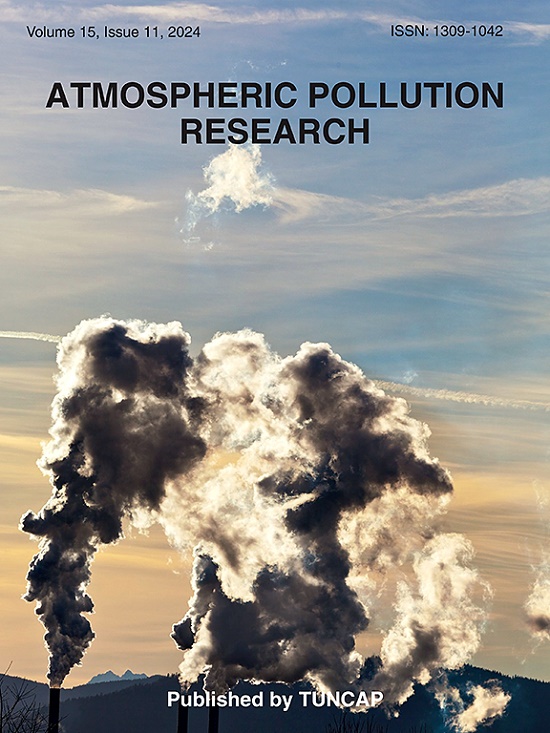哈尔滨地区降水中水溶性离子的化学特征及来源解析
IF 3.9
3区 环境科学与生态学
Q2 ENVIRONMENTAL SCIENCES
引用次数: 0
摘要
降水能有效清除大气污染物,使降水化学成为追踪人类活动对空气质量影响的重要指标。本研究收集了东北特大城市哈尔滨市2021年11月至2023年10月的99份降水样品,分析了降水pH、元素碳(EC)和主要水溶性离子(Na+、K+、Ca2+、Mg2+、NH4+、NO3−、SO42−、Cl−和F−)的浓度。结果表明,总水溶性离子的当量浓度为40.0 ~ 1225.2 μeq·L−1,体积加权平均(VWM)浓度为264.9 μeq·L−1。NO3−、Ca2+、NH4+和SO42−是降水中的优势离子,占总水溶性离子的86.7%。与非加热期相比,加热期降水中大多数离子浓度升高了1.2 ~ 3.6倍。通过富集因子、正矩阵分解(PMF)和逆向轨迹分析,确定了水溶离子的来源,结果表明:Ca2+、K+和Mg2+主要来源于地壳,Na+和Cl−主要来源于海洋,SO42−和NO3−主要来源于人为。此外,对降水中水溶性离子水平的贡献归因于地壳尘埃沉积(29.8%)、生物质燃烧和农业活动(26.0%)以及化石燃料燃烧(22.0%)。确定降水中水溶性离子的潜在源区为哈尔滨市西北部、西南部和南部的城市和地区。从这项研究中获得的知识为制定未来的污染控制政策提供了必要的关键信息。本文章由计算机程序翻译,如有差异,请以英文原文为准。

Chemical characteristics and source apportionment of water-soluble ions in precipitation in Harbin, China
Precipitation can effectively scavenge atmospheric pollutants, making precipitation chemistry a crucial indicator for tracing anthropogenic impact on air quality. In this study, we collected a total of 99 precipitation samples in Harbin, a megacity in Northeast China, spanning the period from November 2021 to October 2023, and analyzed precipitation pH as well as concentrations of elemental carbon (EC) and major water-soluble ions (Na+, K+, Ca2+, Mg2+, NH4+, NO3−, SO42−, Cl−, and F−). Our findings revealed that the equivalent concentrations of total water-soluble ions ranged from 40.0 to 1225.2 μeq·L−1, with a volume weighted mean (VWM) concentration of 264.9 μeq·L−1. NO3−, Ca2+, NH4+, and SO42− were identified the dominant ions in precipitation, collectively accounting for 86.7 % of the total water-soluble ions. The concentrations of most ions in precipitation were elevated by a factor of 1.2–3.6 during the heating period compared to those in the non-heating period. The sources of water-soluble ions were determined through combined analyses involving enrichment factors, positive matrix factorization (PMF), and backward trajectories, which revealed that Ca2+, K+, and Mg2+ were primarily originated from crustal sources, Na+ and Cl− from marine sources, and SO42− and NO3− from anthropogenic sources. Furthermore, contributions to water-soluble ion levels in precipitation were attributed to crustal dust deposition (29.8 %), biomass combustion and agricultural activities (26.0 %), as well as fossil fuel combustion (22.0 %). The potential source regions of water-soluble ions in precipitation were identified as cities and regions located northwest, southwest, and south of Harbin. The knowledge gained from this study provides critical information necessary for formulating future pollution control policies.
求助全文
通过发布文献求助,成功后即可免费获取论文全文。
去求助
来源期刊

Atmospheric Pollution Research
ENVIRONMENTAL SCIENCES-
CiteScore
8.30
自引率
6.70%
发文量
256
审稿时长
36 days
期刊介绍:
Atmospheric Pollution Research (APR) is an international journal designed for the publication of articles on air pollution. Papers should present novel experimental results, theory and modeling of air pollution on local, regional, or global scales. Areas covered are research on inorganic, organic, and persistent organic air pollutants, air quality monitoring, air quality management, atmospheric dispersion and transport, air-surface (soil, water, and vegetation) exchange of pollutants, dry and wet deposition, indoor air quality, exposure assessment, health effects, satellite measurements, natural emissions, atmospheric chemistry, greenhouse gases, and effects on climate change.
 求助内容:
求助内容: 应助结果提醒方式:
应助结果提醒方式:


